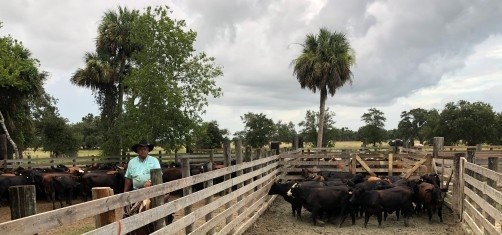Findings to have most impact for beef producers in hot, humid environments.
August 14, 2018

New University of Florida research shows that cattle are more productive when they are cooler because a cooler body aids meat and dairy production.
Cows with shorter hair are cooler and, thus, more productive, said Raluca Mateescu, an associate professor of animal sciences with the University of Florida Institute of Food & Agricultural Sciences (IFAS). A calm cow is also more productive than an agitated one, Mateescu said.
When their bodies heat up, cattle use energy to try to lower their temperature, which usually means they eat less, said Mateescu, who led a recent study on body temperature and cattle traits.
“These findings would have the biggest impact for beef producers in hot, humid environments, largely in the Southeast U.S. and other subtropical and tropical regions of the world,” Mateescu said.
Florida and much of the southern U.S. are in what’s called the subtropics. Places like Brazil, central Africa and the northern half of Australia are in the tropics.
The U.S. livestock industry suffers annual economic losses of $2.36 billion due to heat stress, according to a 2003 study led by The Ohio State University -- the most recent national data available. Scientists predict that most livestock throughout the U.S. will experience extreme summer heat in the years to come, which translates to less-productive cattle, Mateescu said.
For their research, Mateescu and other IFAS colleagues studied 725 Brangus cows in south-central Florida. Brangus are a cross between Brahman and Angus cows and are the most common breed in Florida. Because Angus and Brahman possess such different traits, Brangus cattle are ideal for researching relationships between the animals' coat and demeanor and their body temperature, Mateescu explained.
The IFAS researchers recorded cows’ temperature and temperament as they brought them through a working chute. They also looked at how the cattle behaved.
“Some cattle are very agitated and move a lot in the chute, and they exit the chute by sprinting or jumping, while the calm ones will follow you and won’t kick or shake the chute,” Mateescu said. “Also, they exit the chute calmly, by just walking out.”
As a rule of thumb, when cows’ body temperature rises above 102.4°F, they start eating less and produce less meat or milk, Mateescu said.
Now that the IFAS researchers have shown that cooler, calmer cattle can produce more milk and meat, producers might consider breeding their cattle for these traits, Mateescu said.
The IFAS study was published in the Journal of Animal Science.
You May Also Like


.png?width=300&auto=webp&quality=80&disable=upscale)
